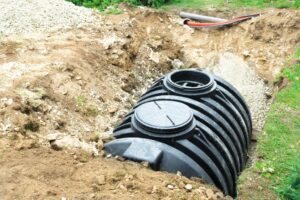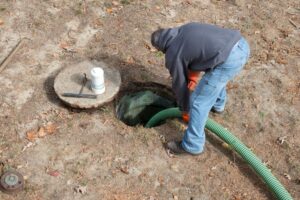Dealing with diverse terrain and varying access to municipal services is a part of living in this stunning Skagit Valley. Homeowners face different challenges in handling their household waste from the rural communities around Mount Vernon and Burlington to the coastal areas of Oak Harbor. Some neighborhoods in Stanwood rely on private septic systems, while others connect to city sewer lines. A wrong choice or poor maintenance can result in raw sewage backing up into your home, contaminating local groundwater, or costing you thousands in emergency repairs. Understanding your wastewater treatment options becomes even more crucial for areas like Sedro Woolley, where properties often sit on large lots away from city centers.
Gateway Septic has been helping Skagit Valley residents navigate these decisions since 1976, providing expert guidance on septic vs sewer systems that work best for each unique property.
This guide breaks down everything you need to know about septic and sewer systems. We’ll help you understand which option suits your property and budget best.
What Is a Septic System?
A septic system acts like your home’s personal waste treatment plant. All the water from your toilets, sinks, showers, and washing machine flows into this underground system for processing.
The key elements cooperate with each other in an easy but effective process:
- Septic Tank: Uses natural bacterial activity to hold and partially treat waste
- Distribution Box: Delivers treated water to the drain field equally
- Drain Field: Uses soil layers to filter out any leftover pollutants
- Soil: Final treatment is done through soil before water reaches the groundwater
How the Treatment Process Works
When waste enters your septic tank, gravity does most of the work. Heavier waste materials sink to the bottom, forming sludge. Oils and grease float to create a scum layer on top. The middle layer contains partially treated liquid that flows to your drain field.
Beneficial bacteria naturally break down organic matter without chemicals or electricity. This process takes 24-48 hours for most household waste. The septic system installation design allows this natural treatment to happen efficiently.
Your drain field completes the cleaning process. Perforated pipes spread the liquid through gravel beds. Clean soil filters out harmful bacteria and excess nutrients before water rejoins the groundwater system.
What Is a Sewer System?
Municipal sewer systems collect waste from entire neighborhoods and transport it to central treatment plants. Think of it as a community approach to waste management where everyone’s waste travels together through underground pipes.
Your home connects through a lateral service line that runs from your house to the main sewer line in the street. From there, progressively larger pipes carry waste to treatment facilities that can handle millions of gallons daily.
The Municipal Treatment Journey
Treatment plants use multiple stages to clean wastewater:
| Stage | Process | Result |
| Primary | Removes large solids and debris | 30% cleaner water |
| Secondary | Biological breakdown of organic matter | 85% cleaner water |
| Tertiary | Final contaminant removal | 95%+ clean water |
Sewer system maintenance happens at the municipal level. To keep pipes flowing and treatment plants operating efficiently, cities make significant investments in infrastructure. They monitor water quality continuously to meet strict environmental standards.
Key Differences Between Septic and Sewer Systems
Ownership and Responsibility
With septic systems, you own everything from your house to the drain field. Septic tank maintenance, repairs, and eventual replacement all fall on your shoulders. This includes regular pumping, monitoring what goes down your drains, and protecting your drain field from damage.
Municipal systems shift most responsibility to the city or utility company. You only maintain the pipes within your property boundaries. Everything from the street to the treatment plant becomes the municipality’s problem.
Cost Structure
Septic system installation requires a big upfront investment but minimal ongoing costs. You’ll pay for pumping every few years and occasional repairs, but no monthly bills.
Sewer connections flip this equation. Lower installation costs, but monthly utility bills that never go away. These fees usually rise annually, which may include special assessments for system upgrades.
Maintenance Demands
Septic systems need your attention to work properly. You must:
- Schedule pumping every 3-5 years
- Monitor water usage to prevent overload
- Protect the drain field from vehicles and construction
- Use septic-safe products for cleaning
Municipal systems require less homeowner involvement. You have to pay monthly and can call for service if an issue arises. Both major infrastructure repairs and routine maintenance are handled by the utility.
Environmental Considerations
Well-maintained septic systems provide a great local treatment. They recharge groundwater naturally and don’t strain municipal infrastructure. However, failing systems can contaminate nearby wells and surface water.
Central treatment plants produce reliable results and manage large volumes efficiently. They use modern technology for complete cleaning, but require extensive pipe networks and high energy consumption.
Common Septic System Troubles and Prevention
Tank Overflow and Backup Issues
When septic tanks fill beyond capacity, waste backs up into your home. Septic pumping in Oak Harbor becomes urgent when you notice slow drains, gurgling sounds, or sewage odors around your property.
Prevention strategies:
- Schedule pumping every 3-5 years based on household size
- Spread laundry loads throughout the week
- Fix leaky fixtures immediately
- Install water-saving devices
Drain Field Failures
Drain field problems represent the most expensive septic repairs. Compacted soil, root interference, and water overload cause system breakdowns. Septic cleaning professionals in Burlington can spot early warning signs before major damage occurs.
Protective measures:
- Keep vehicles off the drain field area
- Plant grass only – no trees or shrubs nearby
- Direct roof and surface water away from the field
- Never build structures over drain lines
System Component Problems
Pumps, alarms, and electrical components fail over time. Septic inspection Oak Harbor services identify worn parts before they cause system-wide failures.
Maintenance tips:
- Test alarms monthly
- Keep electrical connections dry and secure
- Stock spare parts for critical components
- Schedule annual professional inspections
Sewer System Challenges and Solutions
Main Line Blockages and Backups
Tree roots, grease buildup, and debris cause most municipal sewer problems. Septic Stanwood areas may experience fewer issues due to lower population density, but connection problems still occur.
Warning signs to watch for:
- Multiple drains are backing up simultaneously
- Sewage odors from floor drains
- Water is backing up in the basement fixtures
- Unusual sounds from drainage systems
Infrastructure Aging Problems
Older sewer systems have to deal with cracked pipes, root inclusions, and inadequate capacity. Clay pipes deteriorate over decades, while cast iron corrodes and restricts flow. Septic Burlington residents in older neighborhoods face these challenges regularly.
Solutions include:
- Installing backwater valves for protection
- Replacing aging lateral service lines
- Supporting municipal infrastructure improvements
- Reporting problems promptly to utilities
How to Decide Which System Is Best for Your Property
Location and Regulatory Requirements
Rural properties often require septic systems due to distance from municipal lines. Septic tank services in the Mount Vernon area typically offer more flexibility in system choice than urban zones with mandatory sewer connections.
Check local regulations before deciding. Depending on the soil type and the need for environmental protection, some jurisdictions require particular system types, while others forbid new septic installations.
Site Evaluation Factors
The success of septic system installation depends heavily on soil conditions. Sandy soils drain well and support conventional systems. Clay soils retain water and may need advanced treatment options.
Key evaluation criteria:
- Soil percolation rates: The speed at which water percolates through soil
- Seasonal water table levels: System performance is impacted by high groundwater
- Available space: Enough room for drain fields and tanks
- Topography: Slopes have an impact on system placement and design
Cost Analysis Over Time
Compare total costs over 20-30 years, including installation, maintenance, repairs, and replacements. Septic tank services in Stanwood providers often offer maintenance contracts to spread expenses evenly.
Municipal connections have lower initial costs but ongoing monthly fees that increase gradually over time. Consider how comfortable you are performing system maintenance duties.
Water Usage Considerations
Large households or high water usage patterns may favor sewer connections. Septic systems have limited daily capacity and require careful water management. Septic pumping in Sedro Woolley frequency increases with higher usage volumes.
Evaluate your family’s consumption habits and install water-saving fixtures regardless of system type. Monitor usage to identify leaks or excessive consumption quickly.
Maintenance Best Practices for Both Systems
Septic System Care Guidelines
Regular septic tank maintenance will help you avoid expensive failures and greatly increase system life. Professional septic cleaning Mount Vernon services recommend scheduling pumping according to household size and usage patterns.
Daily care practices:
- Use septic-safe cleaning products
- Avoid flushing non-biodegradable items
- Spread water usage throughout the day
- Keep detailed maintenance records
Annual septic system inspection helps identify problems early when repairs cost less. Professional technicians check tank condition, measure sludge levels, and evaluate drain field performance.
Sewer Connection Maintenance
Maintain your lateral service line to prevent costly backups and repairs. Septic inspection in the Sedro Woolley area often has older connections that need attention.
Preventive measures:
- Put in drain screens to collect debris
- Clear tree roots annually if needed
- Report unusual drainage issues promptly
- Consider pipe replacement for aging systems
Septic cleaning Sedro Woolley professionals can also help with sewer line maintenance using specialized equipment for cleaning and inspection.
Conclusion: Choosing the Right System for Long-Term Efficiency
Understanding wastewater treatment options helps you make smart decisions about your property’s infrastructure needs. Both septic and sewer systems provide reliable waste management when properly installed and maintained. The key lies in matching the right system to your specific location, soil conditions, and long-term goals while considering both upfront costs and ongoing maintenance requirements.
Since 1976, Gateway Septic has served the greater Skagit area with reliable and affordable septic services. Our experienced team handles everything from septic tank services in Sedro Woolley to complex installations throughout Oak Harbor, Burlington, Mount Vernon, and Stanwood. We offer comprehensive services, including septic system inspection, pumping, cleaning, repairs, and new installations. Our local knowledge and devotion to customer satisfaction make us your go-to choice for all septic system needs.
Get in touch with Gateway Septic today for professional septic services throughout the Skagit Valley and knowledgeable advice on your septic vs. sewer decision. With decades of experience, our team ensures trustworthy solutions catered to the particular needs of your property. Call us at 360-826-5520 for a consultation and discover why customers trust Gateway Septic for their wastewater system needs.






